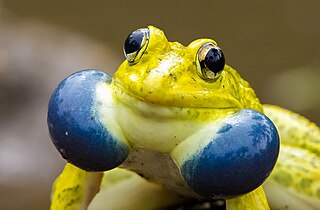Bullfrog is a common English language term to refer to large, aggressive frogs, regardless of species.
Contents
Examples of bullfrogs include:
Bullfrog is a common English language term to refer to large, aggressive frogs, regardless of species.
Examples of bullfrogs include:

The cane toad, also known as the giant neotropical toad or marine toad, is a large, terrestrial true toad native to South and mainland Central America, but which has been introduced to various islands throughout Oceania and the Caribbean, as well as Northern Australia. It is a member of the genus Rhinella, which includes many true toad species found throughout Central and South America, but it was formerly assigned to the genus Bufo.

The banded bullfrog is a species of frog in the narrow-mouthed frog family Microhylidae. Native to Southeast Asia, it is also known as the Asian painted frog, digging frog, Malaysian bullfrog, common Asian frog, and painted balloon frog. In the pet trade, it is sometimes called the chubby frog. Adults measure 5.4 to 7.5 cm and have a dark brown back with stripes that vary from copper-brown to salmon pink.

Pyxicephalus is a genus of true frogs from Sub-Saharan Africa, commonly referred to as African bull frogs or bull frogs. They are very large to large frogs, with females significantly smaller than males. They may take decades to reach their full size potential and they are some of the longest-living frogs, possibly able to reach ages as high as 45 years.

Hoplobatrachus tigerinus, commonly known as the Indian bullfrog, is a large species of fork-tongued frog found in South and Southeast Asia. A relatively large frog, it is normally green in color, although physiological traits vary between populations. Sexual dimorphism exists between males and females. Outside of its native range, H. tigerinus is a rapidly-spreading invasive species. Both adults and tadpoles can severely damage the populations of other frog species. Typically, Indian bullfrogs dwell in wetland environments. Research has been conducted on their ability to control mosquitos.

The giant banjo frog, giant pobblebonk frog, giant bullfrog, or great bullfrog is a species of frog, endemic to Australia, in the family Limnodynastidae. Fry was the first to recognise the species of Giant Banjo Frog as a distinct subspecies of Banjo Frog, differing from the similar Southern or Eastern Banjo Frogs which occupied most of eastern Australia.

The Chinese edible frog, East Asian bullfrog, or Taiwanese frog is a species of frog in the family Dicroglossidae. It is found in Cambodia, China, Hong Kong, Laos, Macau, Malaysia, Myanmar, the Philippines, Taiwan, Thailand, and Vietnam. Its natural habitats are freshwater marshes, intermittent freshwater marshes, arable land, pasture land, rural gardens, urban areas, ponds, aquaculture ponds, open excavations, irrigated land, seasonally flooded agricultural land, and canals and ditches. They breed in spring to early summer.

The African bullfrog, also known as the giant bullfrog or the South African burrowing frog, is a species of frog in the family Pyxicephalidae. It is also known as the pixie frog due to its scientific name. It is found in Angola, Botswana, Kenya, Malawi, Mozambique, Namibia, South Africa, Tanzania, Uganda, Zambia, Zimbabwe, and possibly the Democratic Republic of the Congo. It has been extirpated from Eswatini. It has long been confused with the edible bullfrog, and species boundaries between them, including exact range limits, are not fully understood. Additionally, P. angusticeps of coastal East Africa only was revalidated as a separate species in 2013.

The edible bullfrog, also known as the pixie frog, lesser bullfrog or Peter's bullfrog, is a large-bodied African species of frog in the family Pyxicephalidae.
The Amphibians of Western Australia are represented by two families of frogs. Of the 78 species found, most within the southwest, 38 are unique to the state. 15 of the 30 genera of Australian frogs occur; from arid regions and coastlines to permanent wetlands.

The western banjo frog is a species of frog from the family Limnodynastidae. The informal names for this species are pobblebonk, sand frog and bullfrog. It is one of the endemic amphibians of Western Australia.
P. edulis may refer to:
Edulis, edible in Latin, is a species name present in a number of Latin species names:
The marbled frog is a species of ground-dwelling frog in the family Myobatrachidae native to northern and north-eastern Australia, and southern New Guinea.
The brown frog (Rana) is a genus of about 50 species of true frogs found through much of Eurasia, North America, Africa, Central America, and the northern half of South America.
The eastern frog (Ingerana) is a genus of frogs in the family Dicroglossidae distributed in southeastern Asia, from Nepal, northeastern India, and southwestern China to Indochina, Borneo, and the Philippines.